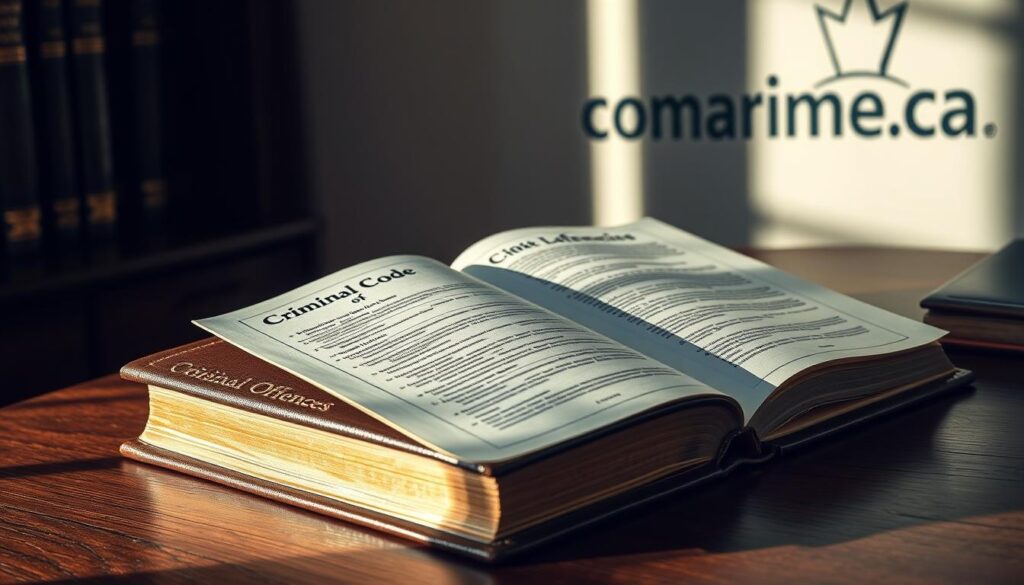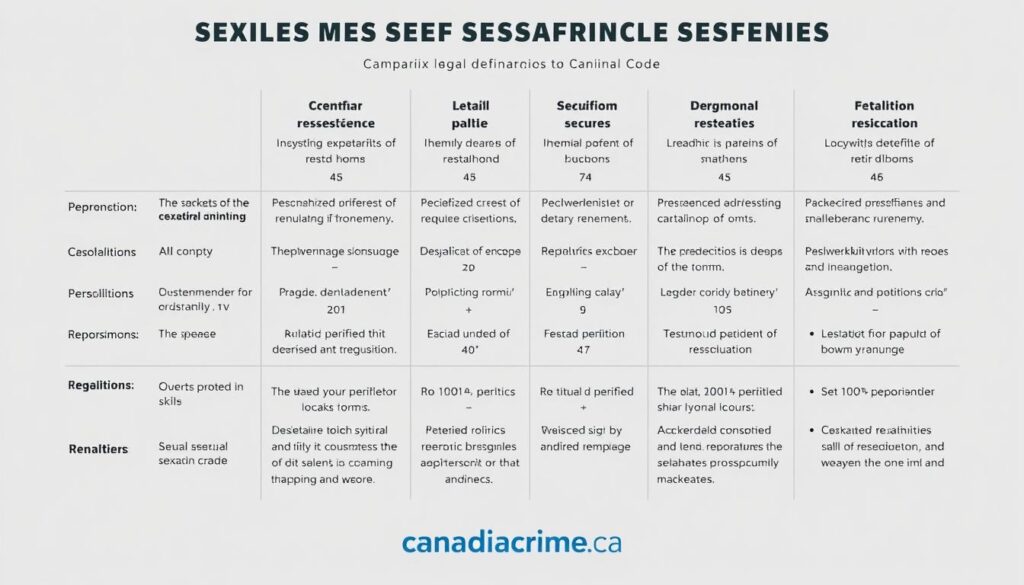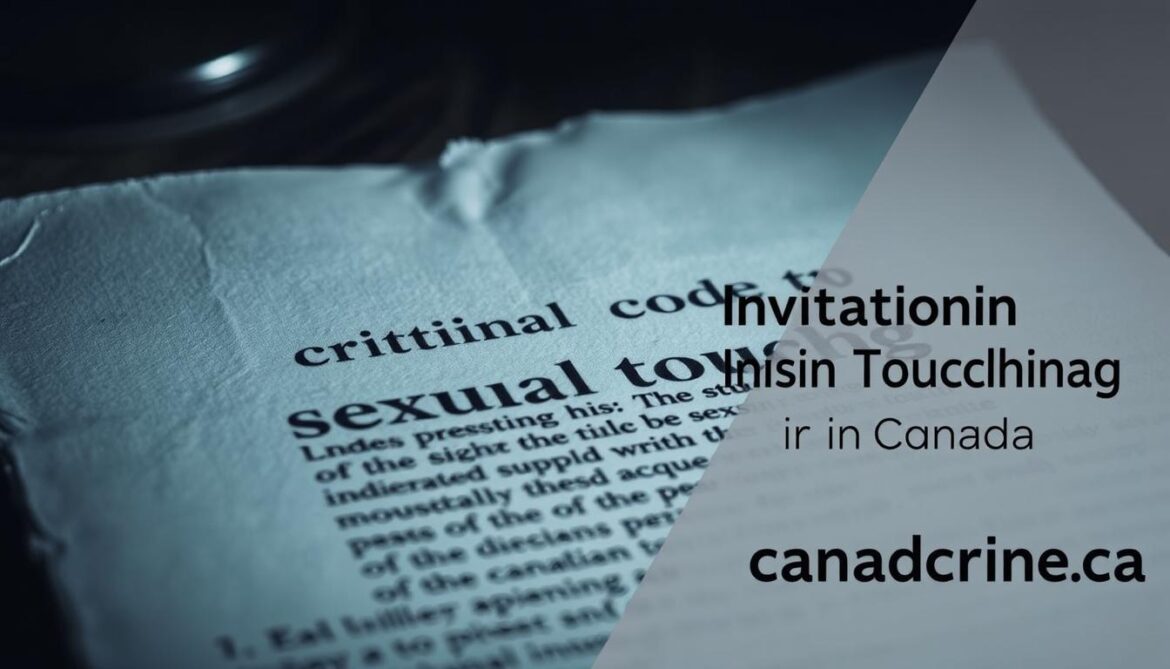Canada reports that 1 in 3 sexual crimes involve victims under 18. This statistic underscores the need for protective legislation. The Canadian criminal code addresses this issue with specific provisions for young people.
Section 152 of the Criminal Code defines invitation to sexual touching as a criminal offense. This law is part of the code covering sexual offenses and public morals.
The law prohibits inviting or inciting anyone under 16 to touch another’s body sexually. This applies to direct or indirect touching, regardless of whose body is involved.
Violating this law carries severe penalties. Convicted individuals may face up to 14 years in prison. The minimum sentence is one year for indictable offenses.
Even summary convictions result in hefty punishments. Offenders could serve up to two years less a day. The minimum imprisonment is 90 days.
Canada’s legal framework strongly protects minors from exploitation. The law’s elements create comprehensive safeguards for young Canadians. These include age thresholds, sexual purpose requirements, and various prohibited actions.
The Legal Definition of Invitation to Sexual Touching
Invitation to sexual touching is a unique offense in Canada’s sexual crime framework. It focuses on communication, not physical contact. This offense targets adults who try to engage minors in sexual activities through communication.
The law addresses various forms of sexual misconduct. It aims to protect minors from exploitation, even without physical contact occurring.
Core Elements of the Criminal Offense
This offense is a communication crime, not an assault. It’s complete upon the communication itself. The Criminal Code requires “positive action” by the accused to establish the offense.
There are three ways to commit this offense:
- Inviting a person under 16 to touch for a sexual purpose
- Counseling a person under 16 to touch for a sexual purpose
- Inciting a person under 16 to touch for a sexual purpose
These methods can work alone or together. The communication doesn’t need to be explicit. Implied invitations can also be criminal if they convey sexual intent.
Age Considerations and Consent Issues
The law protects persons under 16 years old. It recognizes their vulnerability to manipulation and exploitation. This age threshold is absolute, with no exceptions based on relationships.
Consent from the minor is not a valid defense. The law deems those under 16 incapable of consenting to such invitations. This approach shields young persons from sexual exploitation.
Intent Requirements Under Canadian Law
This offense requires specific intent. The prosecution must prove certain mental elements beyond doubt. These include:
| Mental Element | Description | Proof Required |
|---|---|---|
| Knowledge of Communication | Accused must knowingly communicate | Evidence of deliberate communication |
| Sexual Purpose | Communication must be for sexual gratification | Context and content of communication |
| Knowledge of Age | Awareness victim is under 16 | Reasonable steps to ascertain age |
| Intent to Invite | Purpose to have child receive as invitation | Nature and circumstances of communication |
The prosecution must prove the accused knowingly communicated for sexual purposes with someone under 16. They must also show the accused intended the child to receive it as an invitation.
This dual requirement sets this offense apart from other sexual crimes. It reflects its serious nature in Canadian criminal law.
The Criminal Code Framework for Sexual Offenses
Part V of the Criminal Code of Canada outlines sexual offenses laws. It includes Section 152, which addresses invitation to sexual touching. This section falls under “Sexual Offences, Public Morals and Disorderly Conduct.”
Understanding this framework is crucial for those dealing with these serious charges. It provides the legal basis for prosecuting sexual offenses in Canada.
Section 152 of the Criminal Code in Detail
Section 152 targets adults who involve children under 16 in sexual activities. It prohibits inviting, counseling, or inciting minors to touch for sexual purposes.
Every person who, for a sexual purpose, invites, counsels or incites a person under the age of 16 years to touch, directly or indirectly, with a part of the body or with an object, the body of any person, including the body of the person who so invites, counsels or incites and the body of the person under the age of 16 years, is guilty of an indictable offense.
This offense is hybrid in nature. The Crown can proceed by indictment or summary conviction. This allows prosecutors to adapt their approach based on case details.
Historical Development of the Legislation
Section 152 has changed significantly since its creation in 1985. Major amendments in 2005 increased penalties and clarified definitions.
In 2008, the age of consent was raised from 14 to 16 years. 2012 saw the introduction of mandatory minimum sentences.
These changes show Canada’s growing commitment to protecting children from sexual exploitation. Each revision has generally led to stricter penalties and clearer definitions.

Related Sexual Offenses in Canadian Law
Section 152 is part of a network of sexual offenses in the Criminal Code. Understanding these connections helps clarify Canada’s approach to sexual misconduct involving minors.
| Criminal Code Section | Offense | Key Elements | Maximum Penalty |
|---|---|---|---|
| Section 151 | Sexual Interference | Direct touching of a person under 16 for sexual purposes | 14 years imprisonment (indictable) |
| Section 152 | Invitation to Sexual Touching | Inviting a person under 16 to touch for sexual purposes | 14 years imprisonment (indictable) |
| Section 153 | Sexual Exploitation | Sexual touching involving a young person where there is a position of trust | 14 years imprisonment (indictable) |
| Section 271 | Sexual Assault | Non-consensual sexual touching of any person | 10 years imprisonment (indictable) |
These offenses often overlap in practice. Prosecutors may charge multiple offenses for the same conduct. For instance, an adult might face charges under both Sections 151 and 152.
Penalties and Consequences for Invitation to Sexual Touching
Canadian law treats invitation to sexual touching offenses with severe penalties. These consequences go beyond imprisonment. The justice system aims to punish offenders and protect society from future violations.
Mandatory Minimum Sentences
Canadian law sets mandatory minimum sentences for invitation to sexual touching convictions. Indictment cases carry a minimum one-year imprisonment. Summary conviction cases have a 90-day minimum sentence.
These mandatory minimums ensure consistent punishment for offenses involving children. They reflect Parliament’s intent to address these crimes seriously.

Maximum Penalties and Aggravating Factors
The maximum sentences for invitation to sexual touching are substantial. Indictment cases can result in up to 14 years imprisonment. Summary conviction cases have a maximum of two years less a day.
Aggravating factors can increase sentences. These include abuse of trust, victim’s age, and prior convictions. Courts also consider psychological impact and offense planning.
Sex Offender Registry Requirements
Conviction leads to automatic registration with the National Sex Offender Registry. This registration continues after the sentence is completed. It’s separate from imprisonment.
Duration of Registration
The SOIRA requirements mandate a minimum 10-year registration for most offenders. Serious cases may require 20-year or lifetime monitoring. The duration depends on the charge, offender’s history, and offense nature.
Reporting Obligations
Registered offenders must report to police annually. They must notify authorities of changes in address, employment, or education within seven days.
Offenders must report travel lasting seven days or longer. Failing to comply with these reporting obligations is a separate criminal offense.
These measures ensure ongoing surveillance of convicted offenders. They reflect the public safety concerns associated with such offenses.
Distinguishing Between Different Sexual Offenses
Canadian law defines several sexual offenses, each addressing specific prohibited conduct. These distinctions are crucial for legal professionals, defendants, and the public. The Criminal Code sets clear boundaries between seemingly similar offenses.

Comparison with Sexual Assault Charges
Invitation to sexual touching is primarily a communication offense, unlike sexual assault. Sexual assault involves a physical “act or gesture” of sexual nature without consent.
Invitation to sexual touching doesn’t require physical contact. The offense occurs when someone invites, counsels, or incites a young person to engage in sexual touching.
Prosecutors focus on proving the communication itself, not physical contact. This makes the evidence requirements different from sexual assault cases.
Differences from Sexual Exploitation
Sexual exploitation (Section 153) targets a specific relationship dynamic. It applies to situations with 16-17 year-olds where the accused holds a position of trust or authority.
Invitation to sexual touching applies to all persons under 16, regardless of the relationship. Exploitation charges require proof of a trust relationship, like teacher-student or coach-athlete.
Overlapping Elements with Other Offenses
Often, the same conduct might satisfy elements of multiple sexual offenses. An invitation followed by touching could be charged as both invitation and sexual assault.
Prosecutors choose charges based on circumstances and evidence. Courts must carefully handle cases with multiple related charges from one incident.
The table below highlights the key distinctions between these related offenses:
| Offense | Key Elements | Age Considerations | Physical Contact Required | Maximum Penalty |
|---|---|---|---|---|
| Invitation to Sexual Touching | Communication inviting, counseling or inciting sexual touching | Victim under 16 years | No | 14 years imprisonment |
| Sexual Assault | Act or gesture constituting touching of sexual nature without consent | Any age (consent rules vary) | Yes | 10 years to life imprisonment (depending on severity) |
| Sexual Exploitation | Sexual touching where accused is in position of trust/authority | Victim 16-17 years | Yes | 14 years imprisonment |
| Child Luring | Communication via computer system for sexual purpose | Victim under 18 years (varies by offense) | No | 14 years imprisonment |
Legal Defenses in Invitation to Sexual Touching Cases
Understanding legal defenses is vital when facing invitation to sexual touching charges in Canada. These charges have serious consequences. A strategic criminal defense is essential for navigating these complex cases successfully.
Mistaken Belief of Age Defense
A potential defense is mistaken belief about the complainant’s age. This may apply if you honestly thought the person was at least 16. However, Canadian courts impose strict limits on this defense.
You must prove you took all reasonable steps to verify the complainant’s age. Simply accepting what you were told isn’t enough. The court will examine your specific actions to confirm age.
This defense is unavailable when the complainant is under 14. It also doesn’t apply if the accused is in a position of trust or authority.

Limitations of Consent as a Defense
Consent isn’t a valid defense in cases involving minors under 16. Canadian law states young persons can’t provide legally valid consent to sexual activity with adults.
The law protects vulnerable young people who may not understand the implications of sexual activity. Even if a minor seemed willing, this doesn’t constitute a legal defense.
Constitutional Challenges
Various constitutional challenges have been raised against Section 152 of the Criminal Code. These typically involve arguments based on the Canadian Charter of Rights and Freedoms.
Some challenges target mandatory minimum sentences under Section 12 of the Charter. Others focus on freedom of expression concerns under Section 2(b). The core provisions protecting minors have generally been upheld.
Strategic Defense Approaches
Effective defense strategies often challenge specific elements of the Crown’s case. This might include disputing whether communications had a sexual purpose.
Other approaches involve questioning if the interaction was an actual invitation or incitement. Lawyers may also argue the absence of specific intent required for conviction.
- Disputing whether communications had a sexual purpose
- Questioning if the interaction constituted an actual invitation, counsel, or incitement
- Arguing the absence of specific intent required for conviction
- Challenging the reliability or credibility of evidence
These cases require specialized legal representation. An experienced lawyer can identify weaknesses in the prosecution’s case. They can develop strategies based on your specific circumstances.
Reporting and Investigation Procedures
Canada has strict procedures for reporting and investigating invitation to sexual touching cases. These procedures protect victims while ensuring legal due process. Multiple stakeholders follow specific protocols to gather evidence and minimize trauma to young victims.
How to Report Suspected Cases
If you suspect a child is invited to sexual touching, contact local police or child protection services immediately. Certain professionals are legally mandated to report suspected child sexual abuse in Canada.
When reporting, provide specific details about the situation, including names, dates, and observed behaviors. Your identity as a reporter is typically protected by confidentiality laws.
Police Investigation Protocols
Specialized officers trained in child sexual abuse investigations usually handle these cases. The accused may receive an appearance notice or summons without arrest.
If arrested, the accused can be released under specific Criminal Code sections. Release may occur with conditions prohibiting contact with the alleged victim.

Evidence Collection and Preservation
Investigators must gather evidence to prove all elements of the offense. This includes proving the accused’s identity, incident details, and communication with a person under 16.
Evidence must show the communication invited touching for a sexual purpose. Digital evidence, like text messages, is often crucial in these cases.
Protection Measures During Investigations
Throughout the investigation, victim protection remains paramount. Measures typically include limiting child interviews and using child-friendly techniques.
Support persons are provided during questioning. No-contact conditions between the accused and complainant are implemented.
Investigators work with child protection services to ensure the child’s ongoing safety. Special accommodations may include video recording interviews to prevent repeated testimony.
The process balances gathering evidence with protecting the child’s wellbeing. It recognizes the sensitive nature of these cases.
Court Processes and Victim Protections
Canadian courts use special protections in invitation to sexual touching cases. These procedures aim to reduce trauma for victims. They balance the rights of the accused with the needs of vulnerable witnesses.
Special Court Procedures for Sexual Offense Cases
Sexual offense cases follow unique court procedures. Some areas have specialized courts that only handle sexual offenses. This allows judges and staff to become experts in these sensitive matters.
The Criminal Code no longer requires corroboration for sexual offense prosecutions. Section 152 offenses can be summary or indictable. This gives prosecutors flexibility in handling these cases.

Testimonial Accommodations for Vulnerable Witnesses
Courts offer testimonial accommodations to help vulnerable witnesses, especially children. Section 486 of the Criminal Code allows several options:
- Testifying behind screens or via closed-circuit television
- Having support persons present during testimony
- Prohibition of personal cross-examination by self-represented accused
- Video-link testimony options for witnesses who need distance from the accused
Publication Bans and Privacy Protections
Courts can use publication bans to protect victims’ privacy. These bans stop the sharing of information that could identify victims or witnesses.
For Section 152 offenses, judges can order discretionary bans under Section 486.4. These bans are mandatory for witnesses under 18. This encourages reporting and shields victims from public scrutiny.
Victim Impact Statements
Victims can submit victim impact statements during sentencing. These statements describe how the offense affected their lives. They help judges understand the crime’s full impact when deciding on sentences.
Court-appointed victim services can help prepare these statements. Your statement becomes part of the court record. It may influence sentencing decisions, giving you a voice in the process.
Support Resources and Rehabilitation Programs
Canada has developed a network of resources for victims and offenders in sexual touching cases. These resources aim to address healing and prevention through comprehensive approaches.

Support Services for Victims
Specialized victim support services are available across Canada for sexual offense victims. These include crisis intervention, legal advocacy, and emotional support. Organizations like the Canadian Centre for Child Protection offer immediate assistance.
Provinces provide victim assistance programs to help navigate the legal system. These connect you with court preparation, safety planning, and financial aid for counseling. Access often starts through police referrals, with self-referral options growing.
Counseling and Therapy Options
Trauma counseling for sexual offense victims is offered by public and private providers. Approaches include cognitive-behavioral therapy, play therapy, and family therapy. Many provinces cover therapy costs through victim compensation funds.
As noted by one child psychologist,
“The healing journey for young victims requires specialized therapeutic approaches that address both immediate trauma and long-term developmental concerns.”
Support groups provide valuable peer connections for victims and their families. These groups offer a safe space to share experiences and coping strategies.
Offender Rehabilitation Programs
Canada’s correctional system offers specialized offender rehabilitation programs for sexual offense convicts. These include cognitive-behavioral interventions, relapse prevention, and community reintegration support. Research shows comprehensive treatment can significantly reduce repeat offenses.
Programs like the National Sex Offender Program address distorted thinking and develop coping mechanisms. They emphasize accountability and healthy relationship skills to prevent future offenses.
Community Education Initiatives
Community education is crucial for prevention. Schools implement age-appropriate safety programs teaching children about personal boundaries. The Canadian Red Cross offers prevention programs for parents, educators, and youth organizations.
Judges must ensure victims can prepare impact statements before sentencing, as per Section 722(2) of the Criminal Code. This recognizes the importance of victim voices in the justice process.
These approaches support victims, rehabilitate offenders, and educate communities. Together, they create a multi-faceted response to sexual touching offenses. The goal is to heal past trauma and prevent future harm.
Conclusion: Navigating the Legal Landscape
Invitation to sexual touching charges in Canada have serious legal consequences. These can impact your life for years. Such complex cases require specialized knowledge and strategic defense approaches.
If you face these allegations, get qualified criminal defense counsel right away. Small details can greatly affect case outcomes. Your lawyer can identify defenses, handle pretrial procedures, and represent you in court.
For victims and families, knowing the legal framework helps in seeking justice. The Canadian system offers protections to make court less traumatic. It also works to ensure accountability.
The justice system keeps changing its approach to these sensitive cases. It aims to protect children while ensuring fair trials. Mandatory sentences and sex offender registration show society’s commitment to addressing these violations.
Early action and proper support are crucial in these situations. The resources in this guide can help you navigate this tough legal terrain. They provide knowledge for making informed choices.

